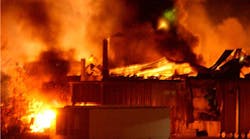“Repeat” and possibly even “willful” violations potentially are in store for Bartlett Milling Co., following an explosion at its Statesville, N.C. facility. While no one was killed in the explosion, one worker seriously was injured and, unfortunately, the company was cited in the past by OSHA for health and safety violations related to the build up of combustible grain dust.
An October 2011 grain elevator explosion at Bartlett Grain Company in Atchison, Kan., killed six workers and left two hospitalized. Following that incident, OSHA cited Bartlett Grain with five willful violations and eight serious violations of workplace safety rules and proposed $406,000 in fines.
At that time, OSHA cited the company for willful violations related to allowing grain dust – which is nine times as explosive as coal dust – to accumulate, using compressed air to remove dust without first shutting down ignition sources, jogging (repeatedly starting and stopping) inside bucket elevators to free legs choked by grain, using electrical equipment inappropriate for the working environment and failing to require employees to use fall protection when working from heights.
"The deaths of these six workers could have been prevented had the grain elevator's operators addressed hazards that are well known in this industry," said Secretary of Labor Hilda L. Solis at the time. "Bartlett Grain's disregard for the law led to a catastrophic accident and heartbreaking tragedy for the workers who were injured or killed, their families and the agricultural community."
The serious violations involve a lack of proper preventive maintenance, certification and lubrication of grain handling equipment; inadequate emergency action plan training for employees and contractors; a lack of employee and contractor training on job hazards; and a housekeeping program that was deficient because it did not prevent grain dust accumulations.
Just 6 months ago, an OSHA inspection at a Bartlett Milling facility in Kansas found violations of OSHA’s safety standards requiring that potentially explosive grain not be allowed to accumulate. Accumulation of combustible flour dust is the prime suspect as the cause of Sunday’s explosion.
While OSHA does have rules to prevent explosions in grain handling facilities like Bartlett’s, workers in other industries are not protected from combustible dust explosions.
“Combustible dust is known to be a huge explosion hazard, yet safety regulators have done little to protect workers from exposure to it,” said Tom O’Connor, executive director of the National Council of Occupational Safety and Health, a federation of local and statewide organizations; a private, non-profit coalition of labor unions, health and technical professionals, and others interested in promoting and advocating for worker health and safety.. “OSHA has been sitting on a combustible dust standard since 2009. Given the prevalence of explosions caused by combustible dust, the agency should promulgate a rule that protects workers from it immediately.”
According to O’Connor, Congress has done little to prevent combustible dust explosions. Legislation pending in the U.S. House of Representatives would give federal OSHA one year to issue stronger standards to protect American workers from combustible dust explosions and fires. Similar legislation passed in the House in 2008 by a large bipartisan majority, following an explosion at Imperial Sugar in Wentworth, Ga., that killed 14 workers and seriously injured 38.
“If it is found that accumulated flour dust was responsible for Sunday’s explosion, OSHA should issue repeat and willful violations against Bartlett Milling Co.,” O’Connor said. “Having been previously cited for this at another facility, the company should be well aware of these hazards. It was only luck that prevented any deaths in this incident.”
The American Industrial Hygiene Association recently sent a letter to Rep. George Miller (D-Calif.), in support of his legislation, H.R. 691, which directs OSHA to issue an interim and final standard regarding worker exposure to combustible dust. The letter also calls for an additional inspection and maintenance requirement and suggests extending the 18-month time frame the bill calls for to propose a final standard.
“AIHA remains concerned that the OSHA Hazard Communication Standard (HCS) inadequately addresses dust explosion hazards and fails to ensure that safe work practices and guidance documents are included in MSDSs,” says the association in its letter to OSHA. “AIHA believes there is an urgent need for further action from the agency to address this issue.”
